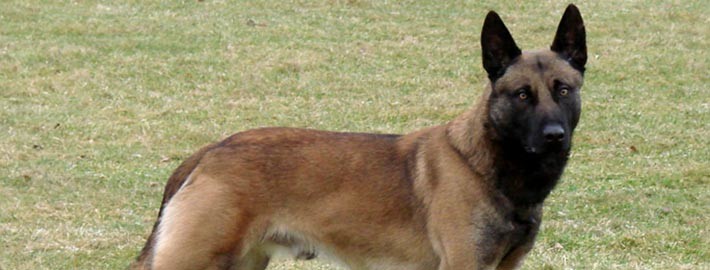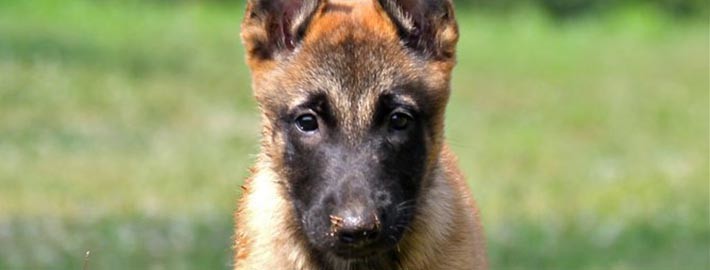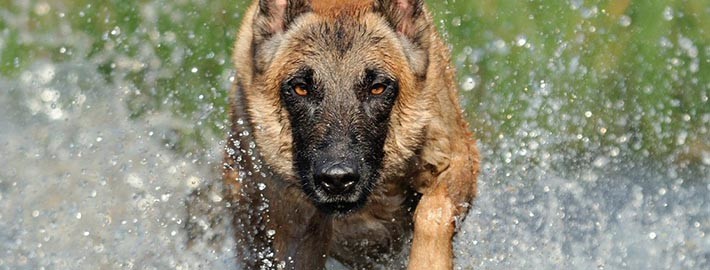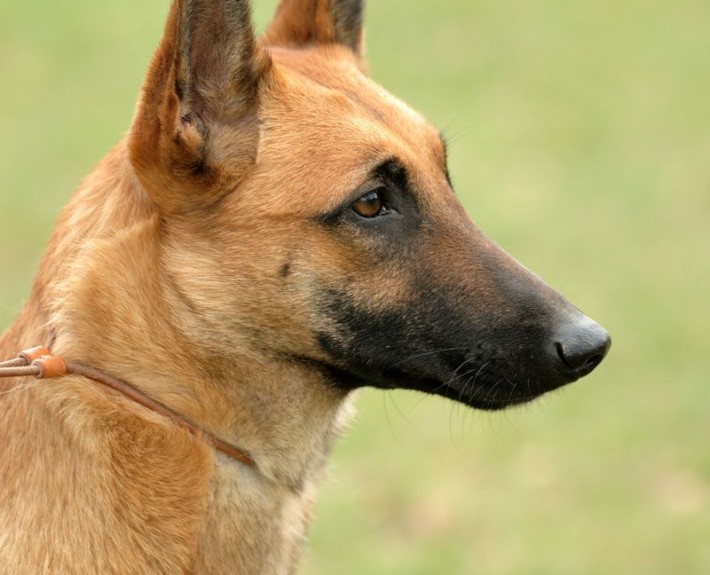What makes the Belgian Malinois Unique?
The Belgian Malinois is a sturdy dog of square proportion with moderately heavy, but oval, bone. It is elegant, with very proud head carriage. The overall impression is of power without bulkiness. The gait is smooth and easy, seemingly effortless rather than hard driving. Such a gait gives the impression of tirelessness. The Malinois has a tendency to run in a wide circle rather than a straight line. Its coat is fairly short, straight, and hard, with a dense undercoat. Its expression is intelligent and questioning. Intense best describes the Belgian Malinois. This is a high-energy breed with a need for regular mental and physical stimulation. It is alert, smart and serious, an ideal watchdog and guard dog. It is aloof with strangers and can be aggressive toward other dogs and animals. Some can be domineering. When confined, it often runs in sweeping circles in an effort to stay on the move. It is protective of its home and family.
Page Contents
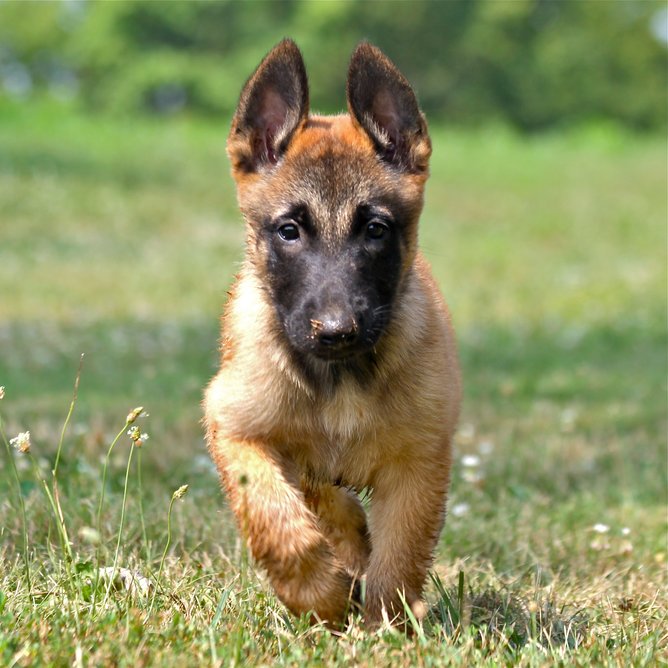
SnapShot
| Size: | Males – 61 to 66 cm (24 to 26 inches) Females – 56 to 61 cm (22 to 24 inches) |
| Weight: | Males – 25 to 30 kg (55 to 65 pounds) Females – 29 to 34 kg (29 to 34 pounds) |
| Origin: | Belgium |
| Life Span: | 12 to 14 years |
| Colour: | Mahogany, Black-masked fawn, Tan, Black-tipped Fawn |
| Litter Size: | 6 to 10 puppies |
Is the Belgian Malinois Right For You?
The Belgian Malinois is one of four varieties of Belgian Sheepdogs, which were developed in Belgium in the late 1800s. The four varieties are the Malinois (fawn-mahogany, short coat with black mask), Tervuren (fawn-mahogany, long coat with black mask) the Laekenois (fawn, rough coat), and the Groenendael (black, long coat). The American Kennel Club (AKC) recognizes all but the Laekenois as separate breeds in the U.S., while the United Kennel Club recognizes all four types as one. Belgian Malinois is a sturdy dog of square proportion with moderately heavy, but oval, bone. It is elegant, with very proud head carriage. The overall impression is of power without bulkiness. The gait is smooth and easy, seemingly effortless rather than hard driving. Such a gait gives the impression of tirelessness. The Malinois has a tendency to run in a wide circle rather than a straight line. Its coat is fairly short, straight, and hard, with a dense undercoat. Its expression is intelligent and questioning.
In 5 Words
- Watchful
- Protective
- Alert
- Friendly
- Hard-working
Characteristics
Learn About the Belgian Malinois
Description
Like all Belgian Shepherds, the Malinois is a medium-sized and square-proportioned dog in the sheepdog family. The Malinois has a short mahogany coat with black markings. It has black erect ears and a black muzzle. It has a square build in comparison to the German Shepherd.
Coat and color
Due to its history as a working dog (i.e., being bred for function over form), the Malinois can vary greatly in appearance. The acceptable colors of pure-bred Malinois are a base color fawn to mahogany and tan with a black mask and black ears with some degree of black tipping on the hairs, giving an overlay appearance. The color tends to be lighter with less black agouti or overlay on the dog’s underside, breeching, and inner leg.
The other varieties of Belgian Shepherd are distinguished by their coats and colors: the Tervuren is the same color as the Malinois but has long hair, the wire-coated Laekenois is fawn and lacks the black mask and ears, and the Groenendael (registered as Belgian Sheepdog by the American Kennel Club) has long hair and is solid black.
The Belgian Malinois can have 12 distinct coat/color markings combinations according to the AKC breed standard. Belgian Malinois AKC markings breed standard
Size
Malinois dogs are about 24–26 in (61–66 cm), while Females are about 22–24 in (56–61 cm) at the withers. Female Malinois are said to average 25–30 kg (55–65 lb), while sires are heavier at 29–34 kg (65–75 lb). They are squarely built.
Short History of the Belgian Malinois
The Belgian Malinois is one of four varieties of Belgian Sheepdogs, which were developed in Belgium in the late 1800s. The four varieties are the Malinois (fawn-mahogany, short coat with black mask), Tervuren (fawn-mahogany, long coat with black mask) the Laekenois (fawn, rough coat), and the Groenendael (black, long coat). The American Kennel Club (AKC) recognizes all but the Laekenois as separate breeds in the U.S., while the United Kennel Club recognizes all four types as one.
The Club du Chien de Berger Belge (Belgian Shepherd Dog Club) was formed in September 1891 to determine which of the many different types of dogs was representative only of the shepherd dogs developed in Belgium. In November of that same year, breeders and fanciers met on the outskirts of Brussels to examine shepherd dogs from that area. After much deliberation, veterinary professor Adolphe Reul and a panel of judges concluded that the native shepherd dog of that province were square, medium-size dogs with well-set triangular ears and very dark brown eyes and differed only in the texture, color, and length of hair. Subsequent examinations of dogs in other Belgian provinces resulted in similar findings.
In 1892, Professor Reul wrote the first Belgian Shepherd Dog standard, which recognized three varieties: dogs with long coats, dogs with short coats, and dogs with rough coats. The Club du Chien de Berger Belge asked the Societe Royale Saint-Hubert (Belgium’s equivalent to the AKC) for breed status, but was denied. By 1901, however, the Belgian Shepherd Dog was finally recognized as a breed.
Today’s Malinois can be traced to a breeding pair owned by a shepherd from Laeken named Adrien Janssens. In 1885, he purchased a pale, fawn rough-haired dog called Vos I, or Vos de Laeken from a cattle dealer in northern Belgium. Janssens used Vos I (which means fox in Flemish) to herd his flock and also bred him to a short-haired, brindle-brown dog named Lise (also known as Lise de Laeken or Liske de Laeken). After that mating, Vos I was bred to his daughters, establishing a line of very homogeneous dogs with grey rough-hairs and short-hairs, and fawn rough-hairs and short-hairs. Today, Vos I and Lise de Laeken are recognized as ancestors not only of the modern Belgian Shepherd Dogs as well as the Bouvier des Flandres and Dutch Shepherd Dogs.
Breeders decided to give each of the different varieties of Belgian Shepherd Dogs their own names. The city of Malines had formed a club for the promotion of fawn shorthairs Belgian Shepherd dog in 1898. Louis Huyghebaert, an early breeder under the “ter Heide” kennel name, as well as a judge, author and the “godfather of the Malinois” (and the Bouvier), along with the Malines club had done much to help popularize these short-hairs, so the name “Malinois” came to be associated with the fawn shorthairs.
In 1897, a year before the formation of the Malines club, Huyghebaert, suggested that since there weren’t very many sheep left in Belgium, that the shepherd dogs should have field trials that showcased their intelligence, obedience and loyalty. From this recommendation, dressage trials for the shepherd dogs were developed that tested a dog’s ability to jump and perform other exercises. The first dressage trial, held on July 12, 1903 in Malines, was won by M. van Opdebeek and his Malinois, Cora van’t Optewel.
Belgian Shepherds were also used as guard dogs and draught dogs. They were the first dogs to be used by the Belgian police. Before World War II, international police dog trials became very popular in Europe, and Belgian dogs earned a number of prizes at the trials.
When World War I broke out, many Belgian Shepherd Dogs were used by the military for a number of jobs including messenger dogs, Red Cross dogs, ambulance cart dogs and, according to some, light machine-gun cart dogs.
During the 1920s and 1930s, several outstanding Malinois kennels were started in Belgium. During the first decades of the 20th century, Malinois and Groenendael were the most popular varieties of the Belgian Shepherd dogs to be exported to other countries. At that time, many were exported to the Netherlands, France, Switzerland, Canada, United States, Argentina and Brazil.
In 1911, two Groenendaels and two Malinois were registered by the AKC as “German Sheepdogs.” In 1913, the AKC changed the name to “Belgian Sheepdogs.” The first dogs were imported by Josse Hanssens of Norwalk, Connecticut. He sold the two Malinois to L.I. De Winter of Guttenberg, New Jersey. De Winter produced several litters from the Malinois under his Winterview kennel name.
After World War I, many American servicemen brought back Malinois and other Belgian Shepherd Dogs from Europe, and AKC registrations increased rapidly. The first Belgian Sheepdog Club of America was formed in 1924 and became a member club of the AKC soon after that. In 1924 and 1925, Walter Mucklow, a lawyer in Jacksonville, Florida, popularized the Malinois through AKC Gazette articles that he wrote. He also bred Malinois for a short time under the name of Castlehead Kennel.
By the end of the 1920s, the Groenendael and Malinois Belgian Sheepdogs had risen in popularity to rank among the top five breeds. During the Great Depression, dog breeding was a luxury that most couldn’t afford, and the first Belgian Sheepdog Club of America ceased to exist. During the 1930s, a few Malinois were registered with the AKC as imports trickled into the country. Even after the Great Depression, there were so few Malinois and interest in the breed had dropped so much that the AKC put them in the Miscellaneous Class at AKC shows in the 1930s and ’40s.
In 1949, a second Belgian Sheepdog Club of America was formed in Indiana. In that same year, John Cowley imported two Malinois and began his Netherlair kennel. He showed several of his dogs and several people became interested in them. By the 1960s, more people were breeding and showing Malinois. In March 1992, the American Belgian Malinois Club received AKC parent club status.
In the last decade, Belgian Malinois dogs have received a lot of attention for their work in the military, drug detection agencies, search and rescue operations, and police forces around the country. As a result, many Malinois have been imported to the U.S. in the last several years. They rank 90th among the 155 breeds and varieties recognized by the American Kennel Club.
Temperament
Well-raised and trained Malinois are usually active, friendly, protective and hard-working. Belgian Malinois exhibit energy levels that are among the highest of all dog breeds. A typical Malinois will have puppy-like energy until the age of three, though it is not uncommon for them to exhibit this energy level until the age of five. Many have excessively high prey drive. Some may be excessively exuberant or playful, especially when young. They can be destructive or develop neurotic behaviors if not provided enough stimulation and exercise. This often causes problems for owners who are unfamiliar with the breed and are not prepared to provide the exercise they require or a job for them to do. They are medium sized, strong dogs that require consistent obedience training, and enjoy being challenged with new tasks. They are known as being very easy to obedience train, due to their high drive for rewards.
Caring for Your Belgian Malinois
Grooming & Bathing
The Belgian Malinois sheds heavily twice a year and sheds little throughout the year. The coat needs to be brushed at least 2-3 times a week with a firm bristle brush to maintain a healthy looking coat. It should be bathed only when absolutely necessary and must be dried properly after each bath. Its eyes and ears need to be cleaned regularly.
Exercise & Training
The Belgian Malinois is a very active and highly intelligent dog that thrives on activity, exercise and playing. Put these three traits together and you have an excellent dog that excels in obedience, tracking, agility, flyball, lure course, herding and even Schutzund. Because of their high energy level, it is important to start their training at an early age to deter them from negative and destructive behavior brought out by boredom.
The Malinois will never get tired of exercise and training, often considering this as part of his playtime. It is very important that you be firm with his training as if given an inch, they will take a foot. The training should begin at a very young age and good behavior should be rewarded with praise. Positive reinforcement works very well with this dog as all he wants to do is please you. Do not be verbally negative with the Malinois as they are very sensitive to negative tones and will not respond as well.

